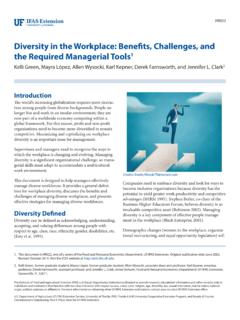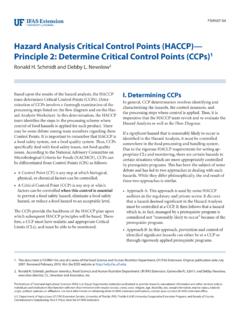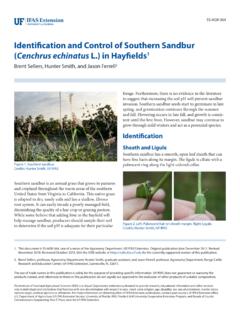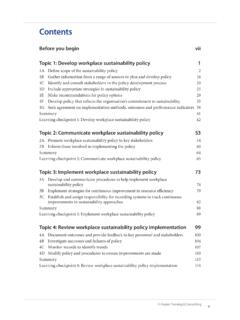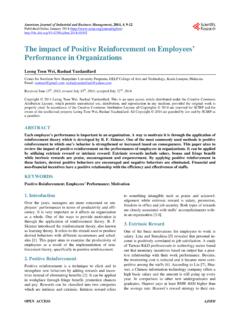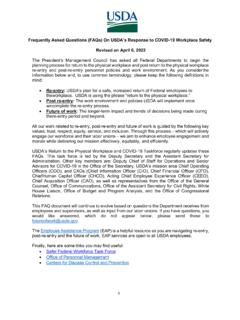Transcription of Understanding Conflict in the Workplace
1 HR024 Understanding Conflict in the Workplace1 Derek Farnsworth, Jennifer L. Clark, Julie Gatlin, Allen Wysocki, and Karl Kepner21. This document is HR024, one of a series of the Food and Resource Economics Department, UF/IFAS Extension. Original publication date June 2002. Revised October 2015 and July 2019. Visit the EDIS website at for the currently supported version of this Derek Farnsworth, assistant professor; Jennifer L. Clark, senior lecturer, Food and Resource Economics Department; Julie Gatlin, former graduate student; Allen Wysocki, associate dean and professor; and Karl Kepner, emeritus professor, deceased; UF/IFAS Extension, Gainesville, FL Institute of Food and Agricultural Sciences (IFAS) is an Equal Opportunity Institution authorized to provide research, educational information and other services only to individuals and institutions that function with non-discrimination with respect to race, creed, color, religion, age, disability, sex, sexual orientation, marital status, national origin, political opinions or affiliations.
2 For more information on obtaining other UF/IFAS Extension publications, contact your county s UF/IFAS Extension office. Department of Agriculture, UF/IFAS Extension Service, University of Florida, IFAS, Florida A & M University Cooperative Extension Program, and Boards of County Commissioners Cooperating. Nick T. Place, dean for UF/IFAS this: it appears you have an easy day ahead of you at your Workplace . Your schedule is not overbooked and things seem to be running according to plan. Upon arrival at work, however, you discover your department s budget has been reduced and new objectives, which you find questionable, have been identified. Your coworkers do not share your point of view. To make matters worse, a report you need within three hours will not be available until the last minute. How should you handle this situation? Understanding Conflict and how it can be used for effective resolution strategies is important for effective communica-tion and productivity in the of Conflict in the WorkplaceWebster s Dictionary (1983) defines Conflict as sharp disagreement or opposition of interests or ideas.
3 In other words, what I want does not match what you want. When Conflict occurs in the Workplace , it can reduce morale, lower work productivity, increase absenteeism, and cause large-scale confrontations that can lead to serious and violent spend a significant portion of their time resolving Workplace conflicts . This obviously affects the productivity of both managers and associates (employees) and can have a far-reaching impact on organizational is a challenge facing both employers and associates. This document explores the type of Conflict most managers and associates would likely encounter on a day-to-day Causes of ConflictAlthough Conflict is often viewed negatively, it can lead to enlightenment if solutions are reached. The first logical steps in resolving Conflict are to identify the problem and then identify what caused the Conflict . Ask yourself: What do the affected parties desire and why are they dissatisfied?
4 Art Bell (2002) suggests six reasons for Conflict in the Workplace : conflicting needs, conflicting styles, conflicting perceptions, conflicting goals, conflicting pressures, and conflicting roles. Brett Hart (2009) discusses two additional causes of Conflict : different personal values and unpredict-able policies. This brings the potential reasons for Conflict to : Conflict in the WorkplaceCause 1. Conflicting NeedsWhenever workers compete for scarce resources, recogni-tion, and power in the company s pecking order, Conflict can occur. Because everyone requires a share of the resources (office space, supplies, the boss s time, or funding) to complete their jobs (Hart 2009), it should come as no surprise when a less satisfied employee submits a complaint (Bell 2002).Cause 2. Conflicting StylesBecause individuals are individuals, they differ in the way they approach people and problems.
5 Associates need to un-derstand their own style and learn how to accept conflicting styles. Personality tests, such as the Myers-Briggs Personal-ity Type Inventory (MBTI), can help people explore their instinctive personality styles (Bell 2002). An example of conflicting styles would be where one worker works best in a very structured environment while another worker works best in an unstructured environment. These two workers could easily drive each other crazy if they constantly work in Conflict with one another and do not learn to accept one another s 3. Conflicting PerceptionsJust as two or more workers can have conflicting styles, they can also have conflicting perceptions. They may view the same incident in dramatically different ways. Bell (2002) gives an example of what might happen if a new administrative assistant were hired in the organization. One associate might see the new hire as an advantage (one more set of hands to get the job done), while another associate might see the same new hire as an insult (a clear message that the current associates are not performing adequately).
6 Memos, performance reviews, company rumors, hallway comments, and client feedback are sources for conflicting perceptions. What was meant gets lost in a firestorm of responses to perceived wrongs (Bell 2002). Resentment and Conflict can also occur when one department is viewed as more valuable to the organization than others (Hart 2009).Cause 4. Conflicting GoalsAssociates may have different viewpoints about an incident, plan, or goal. Problems in the Workplace can occur when associates are responsible for different duties in achieving the same goal. Take for instance the scenario of a patient being admitted to a hospital. The business office is respon-sible for documenting financial information and pursuing payment, whereas the nursing staff is responsible for the patient s physical assessment and immediate admission. Both objectives are important and necessary, but may cause Conflict (Bell 2002).
7 Hart (2009) offers another example. Imagine a bank teller s dilemma in a situation where he is being given conflicting responsibilities by two of his managers. The head teller has instructed the staff that rapid service is the top priority, whereas the community relations director has instructed the staff that quality customer service is the top priority. One can imagine how quickly problems could arise between the teller and the head teller if speed is sacrificed for quality time with the 5. Conflicting PressuresConflicting pressures can occur when two or more associ-ates or departments are responsible for separate actions with the same deadline. For example, Manager A needs Associate A to complete a report by 3:00 , which is the same deadline that Associate B needs Associate A to have a machine fixed. In addition, Manager B (who does not know the machine is broken) now wants Associate B to use the broken machine before 3:00 What is the best solution?
8 The extent to which we depend on each other to complete our work can contribute greatly to Conflict (Hart 2009).Cause 6. Conflicting RolesConflicting roles can occur when an associate is asked to perform a function that is outside his or her job require-ments or expertise or another associate is assigned to perform the same job. This situation can contribute to power struggles for territory. This causes intentional or unintentional aggressive or passive-aggressive (sabotage) behavior. Everyone has experienced situations where associates have wielded their power in inappropriate 7. Different Personal ValuesConflict can be caused by differing personal values. Segre-gation in the Workplace leads to gossiping, suspicion, and ultimately, Conflict (Hart 2009). Associates need to learn to accept diversity in the Workplace and to work as a 8. Unpredictable PoliciesWhenever company policies are changed, inconsistently applied, or non-existent, misunderstandings are likely to occur.
9 Associates need to know and understand company rules and policies; they should not have to guess. Other-wise, unpredictable things can occur such as associates dressing inappropriately or giving out wrong information. The absence of clear policies or policies that are constantly 3 Understanding Conflict in the Workplacechanging can create an environment of uncertainty and Conflict (Hart 2009).ConclusionsThe next time a Conflict occurs, take a moment and ask yourself this series of questions: What may be the cause of the Conflict ? Is it because you or someone needs a resource? Is someone s style different than your own? How do others perceive the situation? Are goal and action-plan priorities in order? Is there conflicting pressure? Is an associate concerned about role changes? Is the Conflict over differing personal values? Is there a clear company policy about the situation?
10 Once a cause is established, it is easier to choose the best strategy to resolve the , A. 2002. Six ways to resolve Workplace conflicts . San Francisco, CA: University of San , B. 2019. Conflict in the Workplace . Behavioral Consultants, s Dictionary. 1983. Conflict . New York: Websters.
